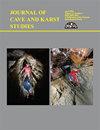Dating and interpretation of recent clastic sediments in an urban cave
IF 0.5
4区 地球科学
Q4 GEOSCIENCES, MULTIDISCIPLINARY
引用次数: 1
Abstract
Capshaw Cave functions as a major stormwater runoff channel for the city of Cookeville, Tennessee, receiving inputs from several large sinkholes. Sediments deposited in the cave reflect the history of erosion and runoff from the city as it grew over the last century. At various locations in the cave, 1 m thick sequences of flood-deposited, laminated fine sediments were observed along the modern stream. Alternating laminations observed in the upper 40 cm of the sediment profile varied between 0.5 cm thick (10Y 7/6 yellow, fine sand) and 2.0 cm thick (10Y 3/2 very dark grayish brown silty sand) layers. Based on measurements of 137Cs activity, the upper 35 cm of sediment was deposited between 1963 (the peak year of 137Cs fallout from nuclear testing) and 2013 (the year samples were collected), at an average rate of 0.7 cm y1. A total of 23 alternating pairs of layers indicate an average flood recurrence interval of 2.2 years between 1963 and 2013. Total Pb concentrations measured in cave sediments showed a peak at the 45 cm depth, suggesting that sediments above this level were deposited after the decline in Pb emissions in the 1970s, and showing general agreement with the timing of deposition suggested by 137Cs. Below 40 cm, the dark silty sand layers were fewer in number and increased in thickness (up to 10 cm), possibly due to changes in cave hydrology or sediment erosion from the surrounding watershed. These findings suggest that, before the 1960s, sedimentation rates were higher and floods were less frequent. After the 1960s, sedimentation rates decreased and floods became more common, probably as a result of urbanization in the watershed.城市洞穴中近期碎屑沉积物的年代测定和解释
卡普肖洞穴是田纳西州库克维尔市的主要雨水径流通道,接收来自几个大天坑的输入。洞穴中沉积的沉积物反映了上个世纪城市发展过程中侵蚀和径流的历史。在洞穴的不同位置,沿着现代河流观察到1 m厚的洪水沉积序列,层状细沉积物。在沉积物剖面上40cm处观察到的交替层状在0.5 cm厚(10y7 /6黄色细砂)和2.0 cm厚(10y3 /2极暗灰褐色粉砂)层之间变化。根据对137Cs活度的测量,沉积物上部35 cm的沉积在1963年(核试验137Cs沉降的高峰年份)至2013年(收集样本的年份)之间,平均沉积速率为0.7 cm y 1。共23对交替层表示1963—2013年平均洪水重现周期为× × 2.2年。溶洞沉积物中总Pb浓度在45 cm处出现峰值,表明45 cm以上的沉积物是在20世纪70年代铅排放下降后沉积的,与137Cs的沉积时间基本一致。在40厘米以下,暗粉质砂层数量较少,厚度增加(可达10厘米),可能是由于洞穴水文的变化或周围流域的泥沙侵蚀。这些发现表明,在20世纪60年代之前,沉积速率更高,洪水更不频繁。20世纪60年代以后,沉降率下降,洪水变得更加常见,这可能是流域城市化的结果。
本文章由计算机程序翻译,如有差异,请以英文原文为准。
求助全文
约1分钟内获得全文
求助全文
来源期刊

Journal of Cave and Karst Studies
地学-地球科学综合
CiteScore
1.90
自引率
0.00%
发文量
6
审稿时长
>12 weeks
期刊介绍:
The Journal of Cave and Karst Studies is a multidisciplinary journal devoted to cave and karst research. The Journal is seeking original, unpublished manuscripts concerning the scientific study of caves or other karst features. Authors do not need to be members of the National Speleological Society, but preference is given to manuscripts of importance to North American speleology.
 求助内容:
求助内容: 应助结果提醒方式:
应助结果提醒方式:


